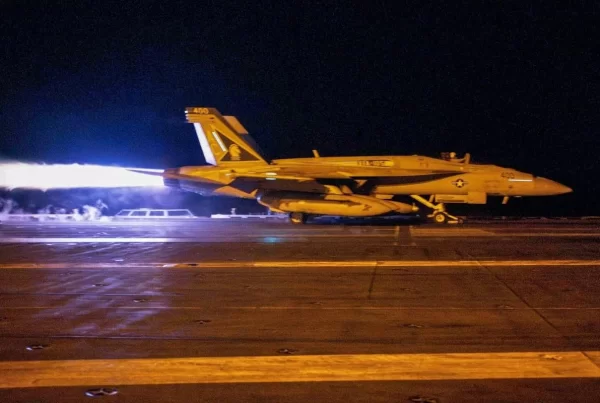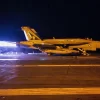By Thomas Harding
Jan 04, 2024
American and British intelligence experts are gathering detailed targeting information for a potential strike on Houthi missile sites, military analysts have told The National.
With continued rebel attacks on Red Sea shipping threatening global trade, the likelihood of significant western retaliation against Yemen is increasing.
Planners are looking at a range of scenarios that include missile attacks, air strikes and raids by special forces.
Despite significant provocation, including an attack on Sunday on a US helicopter by Houthi gunboats that were subsequently destroyed, Washington has deferred striking Yemen to avoid inflaming the combustible Middle East region.
The attacks have had an effect on a route vital to East-West trade, especially of oil, as ships use the Red Sea to gain access to the Suez Canal. In response, some of the world’s largest shipping companies have diverted vessels around southern Africa’s Cape of Good Hope, adding time and cost to voyages.
With those ships still plying the usual route being hit with soaring insurance costs, US inaction is causing concern.
At least 16 major firms have announced rerouted shipments. Denmark’s Maersk and German rival Hapag-Lloyd on Tuesday said their container ships would continue to avoid the Red Sea route that gives access to the Suez Canal.
The disruption could drive up delivery costs for goods, raising fears it could trigger a bout of global inflation.
Those positions could soon change with the US and UK joining an 11-country statement condemning the “illegal and unjustified attacks on commercial shipping in the Red Sea“ by Houthi operatives. The group and its backer Iran were warned to cease the anti-ship operations or face the consequences.
Direct action
Defence Secretary Grant Shapps warned on Wednesday the UK would not hesitate to take “necessary and proportionate action” against the Iran-backed Houthis. Mr Shapps has repeatedly vowed to “deter threats to freedom of navigation in the Red Sea”.
Prime Minister Rishi Sunak’s spokesman told The National that due to the “operational nature” of the situation, “we can’t get into a lot of detail but planning is under way for a range of scenarios”.
“The Houthis should be under no misunderstanding – we are committed to holding them accountable for unlawful seizures and attacks and the situation the Red Sea is serious,” he added.
Sam Cranny-Evans, a military analyst, argued it would be “unwise to allow the Houthis to continue attacks unbridled”.
“Not to act encourages them and Iran feels emboldened by US restraint, so missile strikes could have a good deterrent effect, especially if it demonstrates that the US targeting chain can show ‘we knew exactly where you were when you launched this missile’.”
Tomahawk targets
The last time the US attacked Yemen was in 2016 when it used a barrage of Tomahawk cruise missiles to hit Houthi radar sites after an American warship was attacked.
With three US warships now in the Red Sea, alongside the British Type-45 destroyer HMS Diamond, a formidable western arsenal is on hand.
So far, they have played a defensive role but that could soon change, said Sidharth Kaushal of the Rusi think tank.
“The coalition can continue without achieving the strategic effect intended, so there has to be some mechanism to compel the Houthis to cease firing and that’s likely to be a punitive strike,” he said.
“It’s not a certainty but I think it’s becoming more probable by the day.”
Since the first of the latest wave of attacks in October, the British and Americans have been conducting high-level surveillance of Houthi radar sites, missile launchers, manufacturing hubs, and command and control centres.
Defence sources said the allies have used satellites, drones, RAF P8 Poseidon reconnaissance aircraft and other assets to locate targets, including a missile production plant near the capital Sanaa.
Any initial strikes would almost certainly be a salvo of Tomahawk cruise missiles fired from the three US warships in the Red Sea.
Capable of travelling at more than 900kph with a 450kg warhead, the Tomahawks can be used to destroy a range of ground targets with no risk of friendly casualties.
It is highly likely they are already programmed with target data ready to be fired on US President Joe Biden’s command.
Air strike
There could well be a co-ordinated missile and aerial bombing raid in an attempt to pulverise Houthi capabilities in a swift “shock and awe” operation.
The US fighters would fly from the USS Harry S Truman aircraft carrier based in the Gulf, using their tracking and bombing capability to strike mobile missile and drone launchers.
RAF Typhoon fighter bombers could be launched from their sovereign airbase in Cyprus to join in the attack, although the 2,500km distance to Yemen would require refuelling support from tankers.
“If missile launchers did become the target, then aircraft would be more useful for tracking and engaging relatively elusive targets,” said Dr Kaushal.
“The Houthis are well versed in camouflage capabilities, which makes launchers quite difficult to prosecute as targets.”
Aircraft could also be used against bunkers or industrial sites used in missile manufacturing.
However, the Houthis do possess a number of air defence missiles that had some success during the conflict with Saudi Arabia and UAE, damaging or destroying several aircraft.
“It’s not like they don’t have air defence capabilities,” said Mr Cranny-Evans.
“It’s not the same as striking ISIS, so there is a risk profile that is quite significant.”
Special forces raid
There has been some speculation that US or British special forces could raid harbours to destroy Houthi fast boats with explosives.
Analysts suggest this would be high risk, with the threat of casualties or capture, although covert activity has not been ruled out.
“Special forces might be considered if there’s a particular target that’s hardened or buried or hidden in a way that just makes detection from the air very difficult,” said Dr Kaushal.
With the Houthis likely using fishing boat radar to track Red Sea shipping for missile or drone attacks, these could also become targets for special forces.
Iranian spy ships
Any attack could prompt an escalation with Iran, which has warships in the area and supplies the Houthis with weapons.
An alleged Israeli covert drone or missile attack in 2021 severely damaged the Iranian Saviz spy ship to the north of the Bab Al Mandeb.
Iran has since stepped up its “anti-piracy and intelligence collection” operations with the frigates Alborz in the Red Sea and the Jamaran in the Gulf of Aden.
If it is proven that warships are assisting Houthi attacks, they could themselves become targets, although this would be a significant escalation unless done by covert means.
Happy Houthis
Farea Al Muslimi, of the Chatham House think tank, argued it was questionable what air strikes would achieve, especially given the large land mass of Yemen compared to Lebanon or Gaza.
“It’s not an easy place to try to target or hunt down your enemy,” he said.
“Plus, the Houthis are much more savvy than people think – they should not be underestimated.”
He also warned a US-led attack would play into the Houthi’s hands by allowing them to claim a “new front” against Washington.
“They will actually be happy to finally have a front line with the US so they can boast that they’re taking on the Americans directly,” he said.
This article was published on the national news







